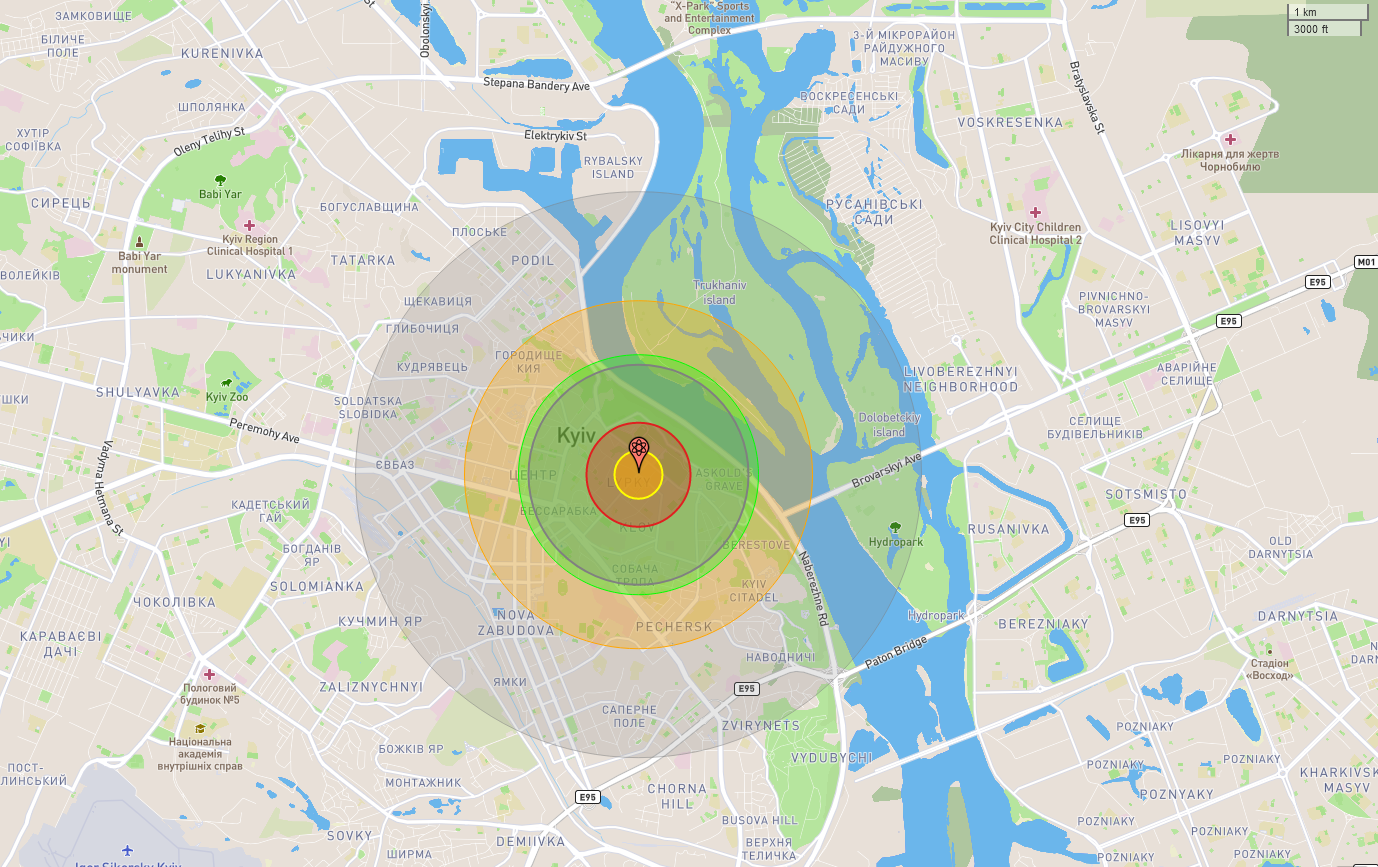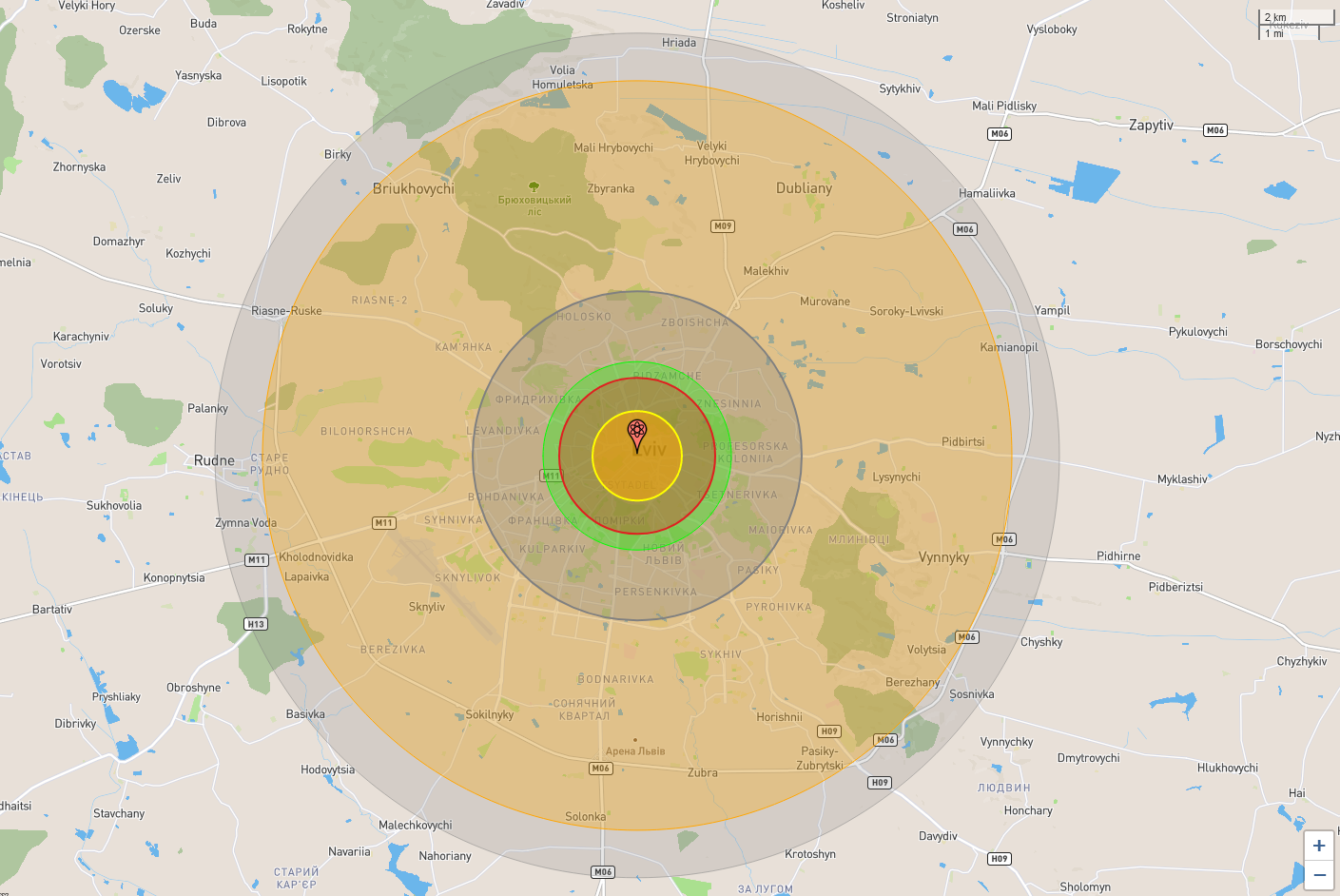The devastation a nuclear attack can cause on Ukrainian cities and how to act
The Russians are trying their best to keep the occupied territories and do not want to leave Ukraine. That is why the Russian Federation’s dictator, Vladimir Putin, once again threatened the whole world with the use of nuclear weapons. "We will use all available means to protect our territorial integrity. And this is not a bluff," threatens Putin.
TEXTY do not intend to rummage through Putin's darkened brains to try to understand whether he is bluffing or not. Unfortunately, we assess the risk of a nuclear attack on Ukraine as high.
Translated by Dmitry Lytov, Mike Lytov
Publication date: 2022-09-23
It is difficult to say when this will happen and what type of weapon will be used. Most likely, it will be a so-called tactical nuclear weapon (the smallest tactical nuclear munition has a power of less than 1 kiloton, that is, its explosion is equivalent to detonating 1,000 metric tons of explosive TNT. The power of the largest of them can reach 100 kilotons, the Ukrainian service of the BBC explains). The Russians are capable of placing tactical nuclear warheads on the missile types that are already being fired at Ukraine. We have seen that they can attack both military and civilian targets to intimidate and force surrender.
According to our estimates, an attack on Ukraine is possible after the apparent failure of the mobilization in the Russian Federation. When the Armed Forces of Ukraine defeat the newly formed units (as it happened to the old ones), Putin can pull out what he considers his strongest trump card - a nuclear strike.
Only fear of retaliation from the US can prevent this. And it is important to know what Washington will do now to intimidate Moscow in order to dissuade the Russian leadership from their many times voiced desire to use nuclear weapons. The fear of a US strike should be greater than the fear of Russia's collapse and loss of power. After all, in the event of Russia's defeat in the Ukrainian war, Putin's power is under threat, and Russia is likely to enter the stage of collapse.
However, the previous history of the war showed that Washington's attempts to stop the escalation on the part of Russia were not successful. This adds pessimism.
Nuclear explosions are extremely destructive, but human experience shows that survival is possible even near the epicenter, especially if you act correctly and are prepared.
This is exactly what happened to the Japanese Tsutomu Yamaguchi, who first survived the bombing of Hiroshima, and a few days later survived in Nagasaki. He suffered many injuries from the explosions, but still maintained relatively good health and lived to be 93 years old.
What happens during a nuclear explosion?
The greatest danger during a nuclear explosion is not radiation, but the thermal impact (heat) and the shock wave. Immediately after the explosion, a ball of fire is formed in its epicenter, which begins to spread around. Its radius will depend on the power of the nuclear munition, on the height at which the bomb exploded, as well as on the features of the terrain. The diameter of the fireball can vary from several hundred meters to several kilometers. If you are not in shelter, then it is impossible to survive within the limits of the spread of the fireball. Everything located in this affected area will, in fact, evaporate.
The explosion will create a blinding flash of light and a powerful wave of heat that will instantly spread away from the epicenter. The diameter of these zones can reach more than 10 km, but, again, will depend on the power of the explosion and the method of detonation of the nuclear munition. The flash of light and heat will bring about fires in the surrounding area and cause serious burns.
A few tens of seconds after that, a shock wave will begin to spread from the epicenter of the explosion, which will simply sweep away everything in its path. Damage will occur both from the wave itself and from the debris of destroyed buildings, lumps of earth and stones. After the explosion, a characteristic mushroom-like cloud will rise, radioactive fallout will begin to fall on the ground, and fires will break out over a radius of many kilometers. The shock wave will roll further, and broken windows and shattered glass will be dangerous to everyone around.
We used the NUKEMAP service to visualize the size of these zones in the event of a hypothetical nuclear strike on the center of Kyiv.
Consequences of an impact by a "Kinzhal" missile with a nuclear warhead (estimated explosion power 25 kilotons). Our anti-aircraft defense cannot shoot down "Kinzhal" missiles yet.

The radius of the fireball (bright orange color) in this case will reach 290 m (about 950 ft), and the heat wave (light orange color) will spread in a radius of 2.11 km (1.31 miles). Mass destruction (red color) will occur within a radius of 640 m (2100 feet, or 0.4 miles) from the epicenter, and windows will fly out at a distance of almost 3.5 km (2.17 miles) from the explosion site (light gray color). The zone of strong radiation contamination (green color) will extend 1.5 km (0.93 miles) from the explosion site. If not sheltered, you can suffer serious radiation burns, which will most likely lead to death within one month of exposure. Most buildings will also be severely damaged within a 1.3 km (0.8 miles) radius of the blast epicenter (dark gray).
A strike by a strategic nuclear missile, for example, on Lviv will be many times more destructive. (It should be noted that even the biggest pessimists in the editorial office do not believe in the use of strategic nuclear weapons against Ukraine). Almost the entire city can be seriously damaged (bright orange, red, and dark gray colors), and fires will spread far beyond its borders (light orange color).
Consequences of the Topol strategic nuclear missile strike (estimated blast power 800 kilotons).

During a nuclear explosion, you need to act as quickly as possible. Your safety depends on every split second. It is necessary to take care of shelter, an emergency suitcase, a supply of water and food in advance. We advise you to use the "Ready for everything"chatbot to develop an appropriate action plan.
The best way to survive a nuclear attack in a city is in a basement with a reinforced concrete floor. It will protect well against radiation and destruction. Ideally, your shelter should have at least two exits, one of which is arranged so that it is not blocked by debris. There should be a supply of food and water sufficient for about a week. You can hide in any other room, but you should stay as far as possible from the walls and make sure that as little air as possible enters from the outside. The majority of the radiation will spread with the fallout from the explosions, which will settle on the outer parts of the buildings.
If the explosion catches you on the street - do not look in its direction. If you see a flash, immediately fall face down on the ground. Try to find at least some kind of shelter to stay in the "shadow" from the heat wave. Cover your head with your hands, preferably with the hood of a jacket or outer clothing. Cover your mouth and nose with a scarf or handkerchief. Beware of debris and try to reach the nearest bomb shelter.
Remain in shelter until it is safe to leave the affected area. Over time, the power of the radiation weakens, so even after 24 hours you will be exposed to a lower dose of radiation than immediately after the explosion.
Procure yourself some personal protective equipment. Protect eyes and respiratory organs with masks, respirators and goggles. Do everything possible to prevent radioactive dust from getting on your skin and inside your body. If you are in a shelter, if possible, carefully remove the top layer of clothing and wash all parts of the body that were exposed. Change into clean clothes if those are available to you. Consume only hermetically sealed water and food.
Rely only on yourself. A nuclear strike is like an earthquake, fire, tornado and flood, all in one. No country in the world is able to fully prepare for such a thing. A nuclear disaster causes infrastructure to collapse, making it impossible to get help for days, if not weeks. Do not neglect your own safety and try to prepare in advance.

